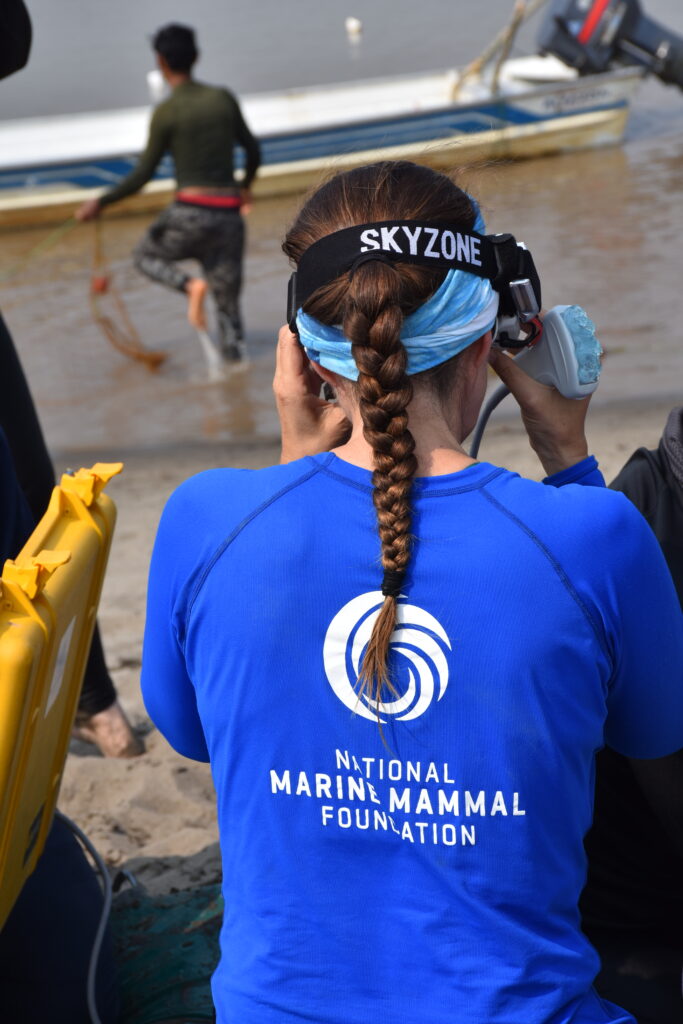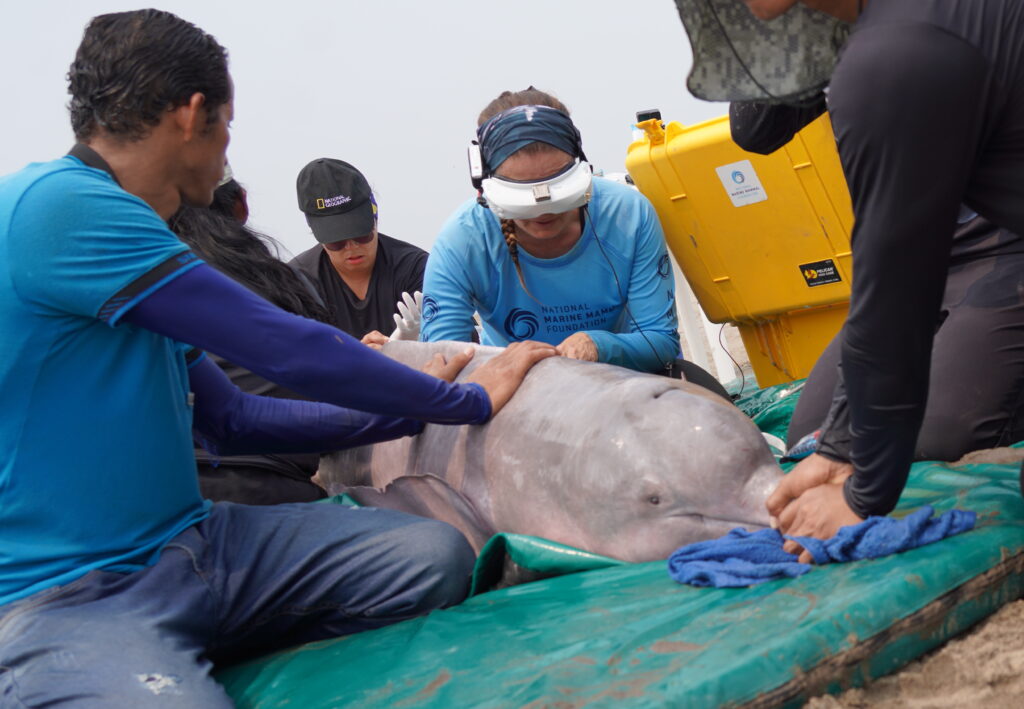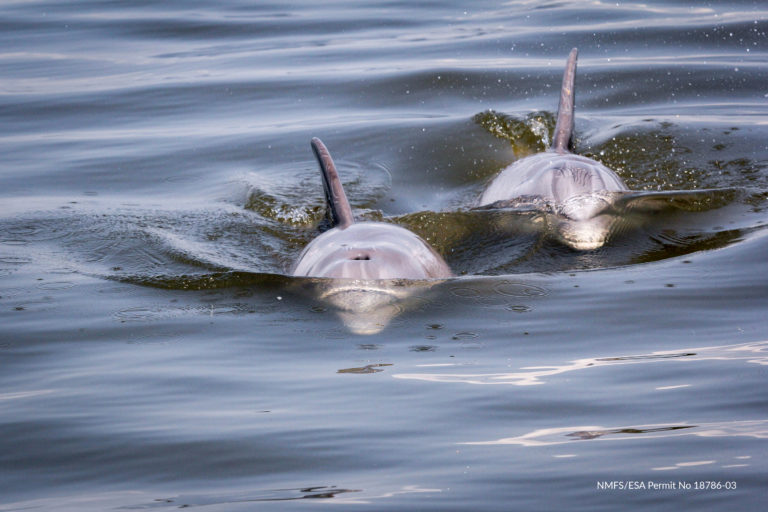Assessing the Health of River Dolphins in the Colombian Amazon Amid Extreme Drought
Adapted from Omacha Foundation’s original press release, distributed in South America on September 28, 2024. Re-released by the NMMF with permission. See original article here.
Contact: Kristina Martz, ex******************@**mf.org
Over the past two years, extreme droughts have impacted the Amazon region, severely affecting riverine communities and aquatic fauna. This has been particularly devastating for Amazon river dolphins. Between September and October 2023, over 330 river dolphins were reported dead in two lagoon systems in Brazil. The causes of death were linked to extreme environmental changes, including record-high water temperatures in the Amazon, reaching 105℉ (41℃), hazardous air quality, and severe drought.
As part of the South American River Dolphin Initiative (SARDI), the health of these species has been monitored in Brazil and Colombia for more than four years to assess the health of the rivers they inhabit.
From August 26 to September 1, 2024, in the midst of an extreme drought, a field effort was conducted to evaluate the health of Amazon river dolphins (Inia geoffrensis), in the Tarapoto Lakes Ramsar/OMEC site along the Amazon River, near the Colombia-Peru border.
This study, led by the Omacha Foundation and funded by Dolphin Quest, was conducted in collaboration with the National Marine Mammal Foundation, the Ikozoa Biopark Foundation, and the Corporation for the Sustainable Development of the Southern Amazon (Corpoamazonía).
Health assessment of a female pink river dolphin (Inia geoffrensis) by Dr. Daniel Alonso, veterinarian and Scientific Director of Bioparque IKOZOA Foundation, and Dr. Forrest Gómez, veterinarian and Director of Conservation Medicine at the NMMF. Photo credit: Dr. Fernando Trujillo, Omacha Foundation.
Assessing the Health Status of River Dolphins
Dr. María Jimena Valderrama Avella, a veterinarian at the Omacha Foundation, explained: “Just as humans undergo medical check-ups to take care of their health, at the Omacha Foundation, with the support of the National Marine Mammal Foundation, we carry out health assessments on river dolphins. These assessments allow us to analyze and understand the health status of this species. Over the past four years, we have developed the Health Assessment program, through which we have collected valuable information and samples that are helping us identify current and future threats. This knowledge is key to generating solutions that protect both dolphins and the rivers that sustain life in the Amazon. Our work is an example of how the health of wildlife is directly connected to the health of our ecosystems and, ultimately, to our own health as humanity.”
During the 2024 evaluation, the Omacha Foundation led the clinical examination of nine dolphins, including their respiratory system, reproductive tract, and other vital organs. Blood samples were also taken to assess kidney, liver, and pancreatic function, as well as the condition of the immune and blood systems.
A coordinated effort between the Omacha Foundation and the NMMF involved a health assessment of a pink river dolphin (Inia geoffrensis) in Puerto Nariño, Amazonas, Colombia, including pectoral fin measurements for morphometric data. Photo credit: Isabella Alonso, IKOZOA Foundation.
Additionally, tissue samples were collected to assess mercury concentrations and to perform genetic studies. Ultrasounds were performed as part of the examinations to evaluate the dolphins’ respiratory and reproductive systems. These assessments were performed on seven female and two male dolphins. A male dolphin was also fitted with a satellite transmitter on his dorsal fin to track the movements of river dolphins within the Amazon River basin. Preliminary findings indicate that while some dolphins were in good health, others showed signs of respiratory illness.
“Following these veterinary examinations, we have a preliminary diagnostic picture of the health of the examined dolphins. The information gathered will fill critical data gaps in our knowledge of the health of this endangered species and inform potential mitigation and conservation strategies at a crucial time. Our veterinary working group brings together doctors from multiple countries, building an important and growing network across South America to help preserve this vital ecosystem. It is an honor to work alongside so many species experts, conservationists, scientists, community members, and dedicated veterinary colleagues to help better understand and protect Amazon river dolphins.”
Dr. Forrest Gomez, National Marine Mammal Foundation
Health assessment of a pink river dolphin (Inia geoffrensis) by Dr. Forrest Gómez, veterinarian and Director of Conservation Medicine at the NMMF, Dr. Fernando Trujillo, Scientific Director of the Omacha Foundation, Dr. Thaís Rodrigues, NMMF veterinarian, Dr. María Jimena Valderrama Avella, Omacha veterinarian, and Dr. Kyle Ross, NMMF veterinarian, with support from others. Photo credit: Milena Lopez, Omacha Foundation.
Jorge Cayetano Santos, territory coordinator and local guide of the Mocagua Indigenous Reservation, participated in the development of the health status assessments. He stated: “Among indigenous peoples, river dolphins are of great importance and as indigenous peoples we did not know that these species also have diseases. I thank the Omacha Foundation for sharing this knowledge and training people from local communities in the region. Feeling the energy of nature is a great experience. We as indigenous peoples of the Amazon Trapezium see this species as very important, and it is also sad to hear that in other villages they are being hunted. We must protect and care for these species that have great energy, they teach us to work as a team and how to live,” and concluded:
"I am very happy to have received this training to learn about the health and biodiversity of our ecosystems. I have been able to share the work that the Omacha Foundation has been doing in recent years, talking about the importance of all this work for the knowledge and conservation of biodiversity."
Jorge Cayetano Santos, Mocagua Indigenous Reservation
Climate Change and the Intensification of Droughts in the Amazon
In this region of Colombia, the rainfall regime creates four major periods that influence the flow of the aquatic environments: high waters (February to April), falling waters (May to July), low waters (August to October) and rising waters (November to January). During the low water period, the water levels decrease, and the fauna, flora, and human communities have adapted to this seasonal cycle. However, recent intense droughts in the Amazon have had severe effects on biodiversity and local communities.
In response, on August 12, 2024, the Municipal Mayor’s Office of Puerto Nariño, Amazonas, declared a State of Public Calamity. Decree 0038 states that: “the indigenous organization ATICOYA, the UMATA of the Puerto Nariño mayor’s office and the PUENAR SAESP highlight the following aspects: In 2024, the dry season began in July with the notable and rapid lowering of the Amazon and Loretoyacu rivers, confirming what was predicted by IDEAM, since mid-May, about the strength of this dry season in the Amazon, stating that for July, August, September and October 2024 in: “the Amazon is expected to have rainfall between 10% and 30% below the reference climatology 1991-2020.” The decree also called for the preparation and approval of a Specific Action Plan.
To prepare for and address a similar crisis in Brazil, scientists from the Amazonian Aquatic Mammal Research Group (GPMAA) of the Mamirauá Institute for Sustainable Development, R3 Animal Association, and the National Marine Mammal Foundation, along with other institutions, developed the Protocol for Amazonian Cetaceans Unusual Mortality Events (UME). This protocol outlines guidelines for monitoring, rescue, clinical support, and immediate release activities for live animals, and the monitoring and analysis of carcasses during mass mortality events of aquatic mammals.
A pink river dolphin (Inia geoffrensis) was safely guided by a team led by Dr. Fernando Trujillo, Scientific Director of the Omacha Foundation, with the support of veterinarians Dr. Forrest Gomez from the NMMF and Dr. María Jimena Valderrama from the Omacha Foundation, along with a local fisherman. Photo credit: Omacha Foundation
Similarly, in Colombia, in response to the severe drought of 2023 and the El Niño phenomenon, the Ministry of Environment and Sustainable Development collaborated with the Alexander von Humboldt Institute and the Omacha Foundation to develop a response strategy for strandings of endangered aquatic vertebrates in the Caribbean, Amazon and Orinoco regions, focusing primarily on manatees and dolphins.
"These types of assessments allow us to understand the health status of rivers, through emblematic species such as dolphins. Healthy rivers will guarantee healthy human populations and the good state of biodiversity. These types of assessments should continue on a regular basis as part of the One Health approach."
Dr. Fernando Trujillo, Omacha Foundation
He added: “At the Omacha Foundation we have received five reports of dead river dolphins since August, in the towns of Puerto Esperanza, Lago El Correo, Patrullero and Boyahuazu, Amazonas. The death of these dolphins is not related to the same causes of high temperatures that occurred last year in Brazil. We have preliminarily identified that the dolphins died trapped in fishing nets. When the water level goes down, unfortunately a large number of nets are placed across the channels from side to side and when the dolphins try to pass, they get trapped and can die.” He also stressed: “In addition, it is important to strengthen and monitor the regulation on the use of fishing gear during the low water season, because people catch larger quantities of fish, the low water season extends for two or three months, and the resource is depleted.”
Two species of river dolphins are found in Colombia: the pink (Inia geoffrensis) and the gray (Sotalia fluviatilis). Both species are listed as Endangered (EN). The governments of Brazil, Colombia, Ecuador, and Peru are currently implementing a Conservation Plan (CMP) for these species within the framework of the International Whaling Commission. Additionally, the Colombian government led the 2023 Global Declaration for the conservation of river dolphins in South America and Asia, which was signed by 11 countries.

Dr. Forrest Gomez, veterinarian and Director of Conservation Medicine at the NMMF, performs an ultrasound on an Amazon river dolphin (Inia geoffrensis). Photo credit: Pablo Ramos, Omacha Foundation.
About the Omacha Foundation
At the Omacha Foundation, we create strategies to ensure the conservation and sustainable use of aquatic and terrestrial ecosystems and species. We work in Colombia, South America and other countries around the world, where we connect local communities and work together in this effort with productive sectors and governments. Our philosophy is to have a permanent presence in the regions to understand and implement biological, social, cultural and economic dynamics that allow us to have a resilient and healthy planet.
About the National Marine Mammal Foundation
The National Marine Mammal Foundation (NMMF) is a 501(c)(3) nonprofit organization recognized globally as a leader in aquatic mammal science, medicine, and conservation. Their team of experts is answering critical questions about the health of the world’s dolphins, porpoises, and whales and the ecosystems they rely on. The NMMF has a mission to improve and protect life for marine mammals, humans, and our shared oceans through science, service, and education. They advance their mission by conducting innovative research and collaborating with the world’s top scientists and institutions to translate their research into applicable medicine and species conservation. The NMMF provides technical, medical, and scientific expertise to help solve problems related to conservation medicine, human-made environmental change, and endangered species recovery. Through Operation GRACE, the NMMF partners with species experts around the world to support health assessments and train communities in conservation medicine, building local capacity to rescue at-risk cetaceans and safeguard their habitats.







